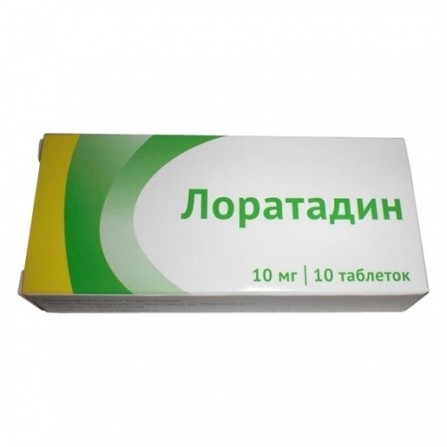Loratadine pills 10 mg 10 pcs
Condition: New product
1000 Items
Rating:
Be the first to write a review!

More info
Active ingredients
Loratadine
Release form
Pills
Composition
Loratadine 10 mg
Pharmacological effect
Histamine H1 receptor blocker. It has antiallergic, antipruritic, antiexudative action. Reduces capillary permeability, prevents the development of tissue edema, reduces the increased contractile activity of smooth muscles due to the action of histamine.
Pharmacokinetics
When administered in a therapeutic dose, loratadine is rapidly absorbed from the gastrointestinal tract and is almost completely metabolized in the body. Cmax of loratadine in plasma is reached after 1-1.3 h, the main active metabolite, descarboethoxyloratadine, after about 2.5 h. With simultaneous ingestion, the bioavailability of loratadine and descarboethoxyloratadine increases by about 40% and 15%, respectively, the time to reach Cmax increased by about 1 h, its values for these substances remained unchanged. Plasma protein binding of loratadine is high - about 98%, the active metabolite is less pronounced. On average, T1 / 2 loratadine is 8.4 h, descarboethoxyloratadine - 28 h (8.8-92 h). About 80% of loratadine is excreted in the form of metabolites in the urine and feces in equal proportions within 10 days, about 27% in the urine during the first days.
Indications
Seasonal and perennial allergic rhinitis, conjunctivitis, acute urticaria and angioedema, gistaminergy symptoms caused by the use gistaminoliberatov (pseudoallergy syndromes), allergic reactions to insect bites, complex treatment of pruritic dermatoses (contact allergodermatity, chronic eczema).
Contraindications
Pregnancy, lactation, children under 2 years old, hypersensitivity to loratadine.
Use during pregnancy and lactation
Loratadine should not be used during pregnancy and lactation. In experimental studies on animals, loratadine in medium doses did not adversely affect the fetus; when administered in high doses, some fetotoxic effects were observed.
Dosage and administration
Inside adults and children over 12 years old, and also with a body weight of more than 30 kg - 10 mg 1 time / day. Children from 2 to 12 years old with body weight less than 30 kg - 5 mg 1 time / day.
Side effects
On the part of the digestive system: rarely - dry mouth, nausea, vomiting, gastritis; in some cases - abnormal liver function. From the side of the central nervous system: rarely - increased fatigue, headache, irritability (in children). Since the cardiovascular system: rarely - tachycardia. Allergic reactions: rarely - skin rash; in rare cases, anaphylactic reactions. Dermatological reactions: in some cases - alopecia.
Overdose
Drowsiness, tachycardia, headache. In case of overdose, consult a doctor and take steps to remove the drug from the gastrointestinal tract and reduce absorption (vomiting, gastric lavage, laxatives, activated carbon). Peritoneal dialysis is ineffective, hemodialysis is not recommended.
Interaction with other drugs
With simultaneous use of loratadine with drugs that inhibit CYP3A4 and CYP2D6 isoenzymes or are metabolized in the liver with their participation (including cimetidine, erythromycin, ketoconazole, quinidine, fluconazole, fluoxetine), the plasma concentration of loratadine and / or these drugs. Inductors of microsomal oxidation (phenytoin, ethanol, barbiturates, zixorin, rifampicin, phenylbutazone, tricyclic antidepressants) reduce the effectiveness.
special instructions
When using loratadine can not completely exclude the development of seizures, especially in predisposed patients. Correction of the dosage regimen is required for patients with impaired renal or hepatic function.





